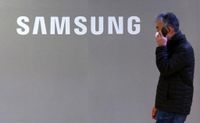Samsung Electronics has found itself trapped in a frustratingly narrow trading range this year, stuck in the 50,000 Korean won (KRW) price bracket despite several attempts to break free. As of early June 2025, the tech giant's stock closed at 56,800 KRW, showing a modest 1.07% gain from the previous day. Yet, this uptick belies a deeper struggle beneath the surface, as foreign investors have been steadily offloading shares, pushing their ownership stake to its lowest point in over a year.
According to data from the Korea Exchange, Samsung's foreign ownership fell to 49.65% as of June 2, 2025, down from 56.48% just before the August 2024 "Black Monday" market turmoil. This decline has been marked by persistent net selling every month in 2025 except for a brief respite in March, when hopes for a rebound in dynamic random-access memory (DRAM) prices led to a temporary buying spree. Since January, foreign investors have unloaded a staggering 4.511 trillion KRW worth of Samsung shares, with April alone accounting for 2.776 trillion KRW in net sales.
In stark contrast, SK Hynix, Samsung's main competitor in the semiconductor space, has enjoyed a wave of foreign investor enthusiasm. In May 2025, SK Hynix was the most net-bought stock by foreign investors, with purchases totaling 1.476 trillion KRW, while Samsung was the top net-sold stock, with sales of 1.278 trillion KRW. This divergence is partly fueled by SK Hynix's role as a key supplier of high-bandwidth memory (HBM) to Nvidia, the American chipmaker whose stock surged recently on expectations of booming artificial intelligence (AI) semiconductor demand. Nvidia reclaimed its spot as the world's largest company by market capitalization in early June, a position it hadn't held since late January 2025.
Samsung's stock price has mirrored these market dynamics. After breaching the 60,000 KRW mark in mid-October 2024, it briefly rebounded to that level in March 2025 but has since slipped back into the 50,000 KRW range. On June 4, 2025, Samsung traded at 57,750 KRW, up 1.67% from the previous day, marking five consecutive days of gains. Meanwhile, SK Hynix surged 5.9% to 219,750 KRW, even touching 223,000 KRW during the session.
Analysts point to Samsung's uncertain position in the high-stakes HBM market as a central reason for its muted performance. While the company is striving to enter the HBM3e segment through a redesign of its products, the rapid pace of HBM generation shifts means that this effort may not translate into immediate market gains. Han Dong-hee, a researcher at SK Securities, noted, "Samsung Electronics is making strenuous efforts to break into the HBM3e market through redesign, but the speed of HBM generation transitions does not wait for these changes. Therefore, the certification of the HBM3e redesign is unlikely to act as a short-term surprise boosting HBM performance." This sentiment underscores the challenges Samsung faces in keeping pace with technological evolution in a fiercely competitive industry.
The company's market share dynamics further illustrate this challenge. Market research firm TrendForce reported that in the first quarter of 2025, Samsung lost its top spot in global DRAM market revenue to SK Hynix. Samsung's share fell sharply from 39.3% in the previous quarter to 33.7%, while SK Hynix's share dipped only slightly from 36.6% to 36.0%, enabling it to reclaim the number one position. This reversal is striking, especially considering that just a year prior, Samsung held a commanding 43.9% share compared to SK Hynix's 31.1%.
Despite these hurdles, Samsung's valuation metrics suggest the stock remains attractively priced. As of June 2, 2025, its price-to-book ratio (PBR) stood at 0.98, indicating that the market values the company at less than its net asset value. This undervaluation, combined with ongoing share buyback programs, tempers fears of a significant further decline in the stock price. Noh Geun-chang, head of research at Hyundai Motor Securities, commented, "Considering valuation attractiveness and share repurchases, the risk of further downside is limited. However, if the fundamental competitiveness of HBM does not improve, it is appropriate to approach Samsung Electronics within the current box range." Similarly, Kang Jin-hyeok of Shinhan Investment Corp. pointed out that Samsung's foreign ownership levels resemble those seen during the pandemic low, suggesting that while skepticism about its technology persists, there is room for recovery if trade tensions ease and risk appetite returns.
The ongoing tug-of-war between foreign investors' cautious selling and the company's efforts to innovate in memory technology encapsulates the broader uncertainty gripping Samsung's stock. While the immediate risk of a sharp price drop appears limited, breaking out of the entrenched trading range will likely hinge on tangible progress in the HBM business and a demonstration of clear technological leadership.
For now, Samsung Electronics remains in a holding pattern, a giant navigating the shifting currents of global semiconductor competition and investor sentiment. The market watches closely, waiting to see if the company can translate its R&D efforts into market share gains and renewed investor confidence—or if it will continue to tread water in the 50,000 KRW box range.

